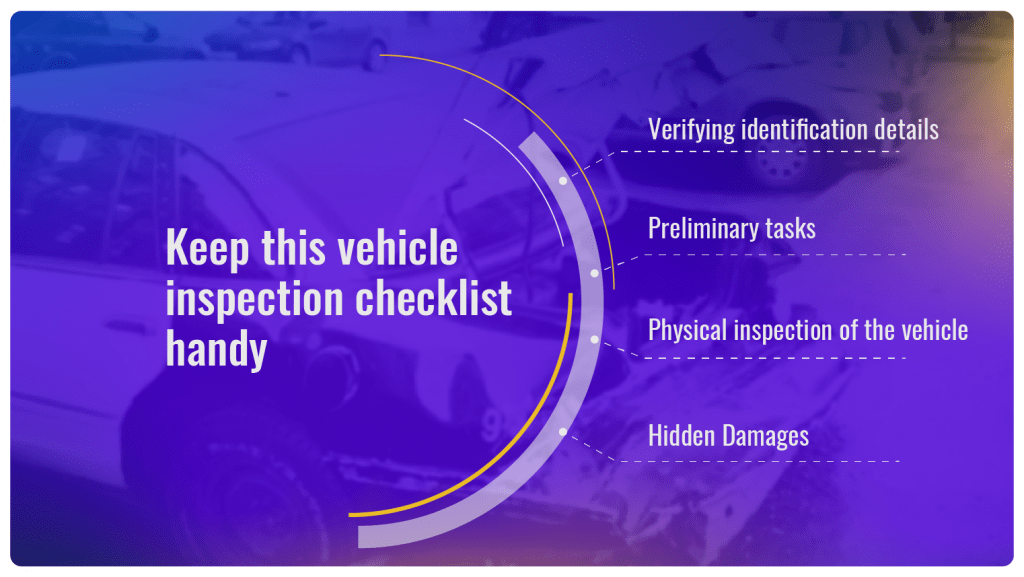At A Glance

The vehicle inspection process is an inseparable part of vehicle insurance. A car needs to be inspected for a number of reasons. It might’ve been in an accident, and the carrier needs to assess the damage, or it might’ve almost totaled and the insurer needs to take the call on whether it needs to be salvaged. Vehicle inspection is also required before leasing out cars to expose any hidden damages and establish the actual ‘health’ of the car. Whatever the reason, the vehicle inspection process can turn into a long-drawn out affair if all the parties involved in the process do not have a clear idea of what it entails.
In this blog, we explain the stages involved in the vehicle inspection process. We will also compare two primary methods of inspecting cars: the manual way and the AI way.
Steps of the Vehicle Inspection Process
A vehicle inspection seeks to clarify if the car is road-worthy. Is it safe for the driver? Does it need repairs and maintenance? In some cases, vehicle inspectors will also consider how environment-friendly the car is, and whether it will cause a ton of emissions on account of internal damage or neglect.
In order to answer these questions, the vehicle inspection process goes through a set of steps.
-
-
Verifying identification details
Before taking on the tasks of actually inspecting a vehicle, the inspector needs to verify some details, both of the vehicle and the car owner. The insurance carrier or broker takes down these details when the customer approaches them for inspection. The vehicle details that need to be considered are the make and model, year of manufacture, and the VIN number that’s associated with every car (stamped under the windshield).
-
Preliminary tasks
Before analyzing the vehicle part by part, an inspector first completes a couple of initial steps. They include making sure the car actually starts and the engine runs, and jotting down the odometer reading. This is well-documented both for later reference and as proof for the car owner.
Now the inspector can move towards assessing the condition of the parts of a vehicle. -
Physical inspection of the vehicle
Damage to the immediately visible parts of a car is obvious to the eye. Vehicle inspectors will tackle this first so that it is out of the way before they can turn to the ‘invisible’ damage. There is no set order for this, but there are checklists available which ensure a thorough job was done.
These checklists include mirrors, windshields, tail-lights, fenders, doors, tires (for tread-depth or grip) and the interior as well, like the steering wheel, the gear stick, windows, and even under the hood for leaks or out of place tiny components.
Some inspectors use a binary, broken/not broken checklist for assessing a vehicle’s damage, while others can use a graded percentage rating. Inspectors will check for cracks, scratches, dents, fitting issues, and durability problems.
Throughout the inspection process, vehicle inspectors will meticulously note down the details. It is highly advised that along with notes they take pictures from different angles, so there’s visual evidence.
-
Hidden Damages
Up until this stage, a person can do a thorough vehicle inspection the manual way. But sometimes, the impact of an accident or say a flood can cause damage that’s not visible to the human eye. This includes rusting, loose wires, moisture damage, and car part aging. To expose this damage, the car would need to be stripped apart! Barring a few extreme cases, an inspector would obviously like to avoid doing this.
So, should the vehicle inspection process grind to a halt after the physical inspection? Absolutely not. A, a human inspector can only be so thorough, and B, their stamp of approval on the damage might not be entirely accurate.
This is where artificial intelligence steps in. AI, using the power of image recognition and computer vision, can scan for hidden damage that is far too obscured for even the trained vehicle inspector.
-
How does it work?
Tools like Claim Genius’s GeniusPREINSPECT use snapshots of a vehicle to assess vehicle damage. All a carrier needs to do is to take a few snaps of the vehicle from different angles, and upload them via our mobile AI app. Genius PREINSPECT will then perform a complete damage assessment that is both faster and more accurate. We give you detailed reports of our AI’s damage analysis and you can take informed decisions for your customer.
If you want to speed up the vehicle inspection process and get back your waiting customer quicker, connect with us and we’ll take it further.


Your site really helped me
Your site really helped me thanks a lot
Thanks for the comment! If you need any additional help with auto insurance solutions, feel free to reach out to us: https://claimgenius.learnedstudio.com/contact-us/
I like the tip that you gave that image and computer recognition would be used for the inspection. My best friend informed me the other day that he was hoping to find a reliable logbook servicing that could provide proper overall maintenance for his car, and he asked if I had any idea what is the best option to consider. I’m glad about this informative article, I’ll tell him that he can consult a well-known car service in town as they can provide preventative measures.
Thanks for leaving your feedback on our article! We are glad it gave you some insights. You are most welcome to share it with anyone who you think will benefit from it.